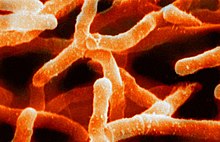| Actinomyces | |
|---|---|

| |
| Scanning electron micrograph of Actinomyces israelii | |
| Scientific classification | |
| Domain: | Bacteria |
| Phylum: | Actinomycetota |
| Class: | Actinomycetia |
| Order: | Actinomycetales |
| Family: | Actinomycetaceae |
| Genus: | Actinomyces Harz 1877 (Approved Lists 1980)[1] |
| Species | |
|
See text. | |
| Synonyms | |
| |
Actinomyces is a genus of the Actinomycetia class of bacteria. They all are Gram-positive and facultatively anaerobic, growing best under anaerobic conditions.[2] Actinomyces species may form endospores, and while individual bacteria are rod-shaped, Actinomyces colonies form fungus-like branched networks of hyphae.[3] The aspect of these colonies initially led to the incorrect assumption that the organism was a fungus and to the name Actinomyces, "ray fungus" (from Greek actis, ray or beam, and mykes, fungus).
Actinomyces species are ubiquitous, occurring in soil and in the microbiota of animals, including the human microbiota. They are known for the important role they play in soil ecology; they produce a number of enzymes that help degrade organic plant material, lignin, and chitin. Thus, their presence is important in the formation of compost. Certain species are commensal in the skin flora, oral flora, gut flora, and vaginal flora[4] of humans and livestock. They are also known for causing diseases in humans and livestock, usually when they opportunistically gain access to the body's interior through wounds. As with other opportunistic infections, people with immunodeficiency are at higher risk. In all of the preceding traits and in their branching filament formation, they bear similarities to Nocardia.[5]
Like various other anaerobes, Actinomyces species are fastidious, thus not easy to culture and isolate. Clinical laboratories do culture and isolate them, but a negative result does not rule out infection, because it may be due simply to reluctance to grow in vitro.
- ^ Harz CO. (1877–1878). "Actinomyces bovis, ein neuer Schimmel in den Geweben des Rindes" [Actinomyces bovis, a new mold from the tissues of cattle]. Deutsche Zeitschrift für Thiermedizin. 5: 125–140.
- ^ Cite error: The named reference
Baronwas invoked but never defined (see the help page). - ^ Holt JG, ed. (1994). Bergey's Manual of Determinative Bacteriology (9th ed.). Williams & Wilkins. ISBN 0-683-00603-7.
- ^ Petrova, Mariya I.; Lievens, Elke; Malik, Shweta; Imholz, Nicole; Lebeer, Sarah (2015). "Lactobacillus species as biomarkers and agents that can promote various aspects of vaginal health". Frontiers in Physiology. 6: 81. doi:10.3389/fphys.2015.00081. ISSN 1664-042X. PMC 4373506. PMID 25859220.
- ^ Sullivan, DC; Chapman, SW (2010), "Bacteria that masquerade as fungi: actinomycosis/nocardia", Proc Am Thorac Soc, 7 (3): 216–221, doi:10.1513/pats.200907-077AL, PMID 20463251.